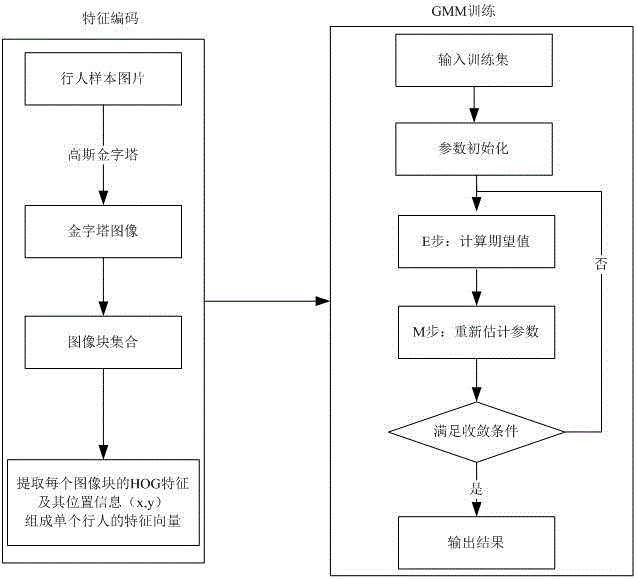Pedestrian detection method based on self-learning
A pedestrian detection and self-learning technology, applied in the field of pedestrian detection based on self-learning, can solve problems such as inability to adapt to specific tasks
- Summary
- Abstract
- Description
- Claims
- Application Information
AI Technical Summary
Problems solved by technology
Method used
Image
Examples
Embodiment 1
[0053] Such as figure 1 As shown, the present invention provides a pedestrian detection method based on self-learning, comprising the following specific steps: first train a cascade classifier based on AdaBoost as an offline classifier, and simultaneously use a group of public pedestrian photos to train a Gaussian mixture model, feature encoding Using HOG features and location information, and then using a low-threshold offline classifier to detect pedestrians in specific scenes, and output the confidence scores of candidate objects, then select high confidence scores as positive samples, low confidence scores as negative samples, and use Gaussian The hybrid model re-represents the candidate detection objects, and finally uses the SVM classifier to train a discriminative pedestrian classifier online to re-predict the candidate objects and output probability estimates.
[0054] The offline classifier described in the above steps: the training data comes from any pedestrian data...
Embodiment 2
[0059] Such as figure 2 As shown, the offline classifier is trained using the cascade classifier in OpenCV, including two parts: data set preparation and running training program, wherein the data set is prepared as training data: use opencv_createsamples to create a set of positive samples, and manually prepare a large number of negative samples. Sample picture; run the training program to train the cascade classifier: set the feature type to LBP. Considering that the training and detection speed of the LBP feature is several times faster than that of the Haar feature, the LBP feature is used to train the cascade classifier using opencv_traincascade.
Embodiment 3
[0061] Such as image 3 As shown, the Gaussian mixture model includes two parts of feature encoding and GMM training, specifically:
[0062] Feature encoding: For each pedestrian picture in the INRIA dataset, a three-layer Gaussian pyramid is first constructed, and then overlapping image blocks are extracted from each layer of the image pyramid. Assume that each pedestrian picture includes N image blocks Extract the HOG feature hog of each image block pi and its location information l pi =[xy] T , and finally the feature encoding of each image block is f pi =[hog pi T , l pi T ] T , all image blocks constitute pedestrian sample features
[0063] GMM training: A Gaussian mixture model trained offline can be expressed as
[0064]
[0065] Among them, K is the number of Gaussian mixture components, I is the identity matrix, is the mixture weight composed of the kth Gaussian, is a Gaussian distribution with mean μ k and the variance is f is the pedestrian...
PUM
 Login to View More
Login to View More Abstract
Description
Claims
Application Information
 Login to View More
Login to View More - R&D
- Intellectual Property
- Life Sciences
- Materials
- Tech Scout
- Unparalleled Data Quality
- Higher Quality Content
- 60% Fewer Hallucinations
Browse by: Latest US Patents, China's latest patents, Technical Efficacy Thesaurus, Application Domain, Technology Topic, Popular Technical Reports.
© 2025 PatSnap. All rights reserved.Legal|Privacy policy|Modern Slavery Act Transparency Statement|Sitemap|About US| Contact US: help@patsnap.com



